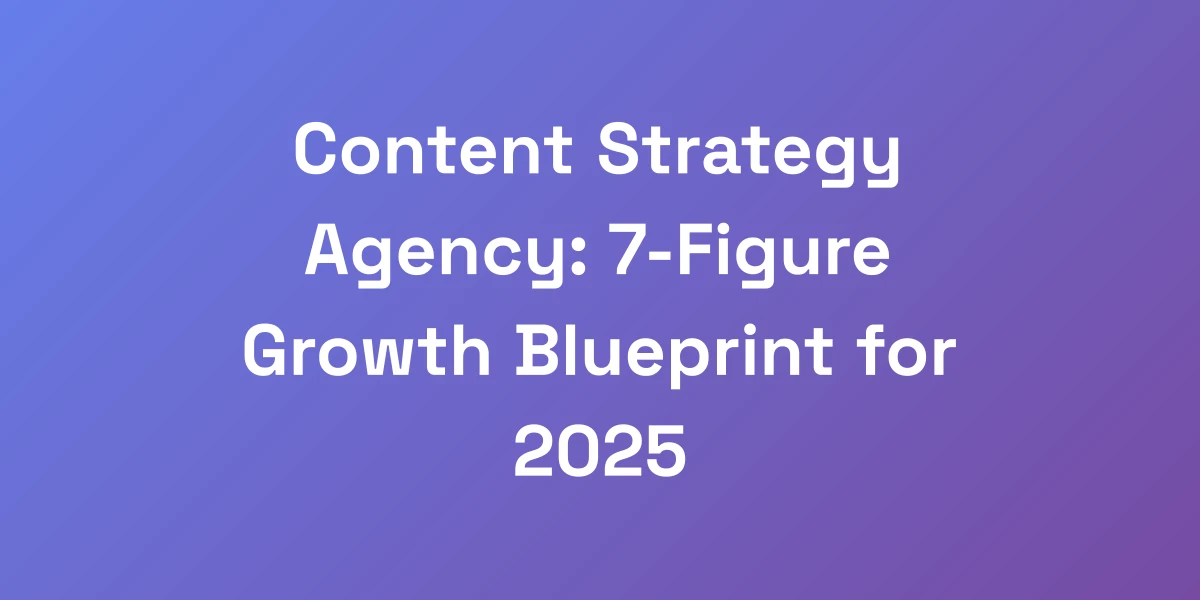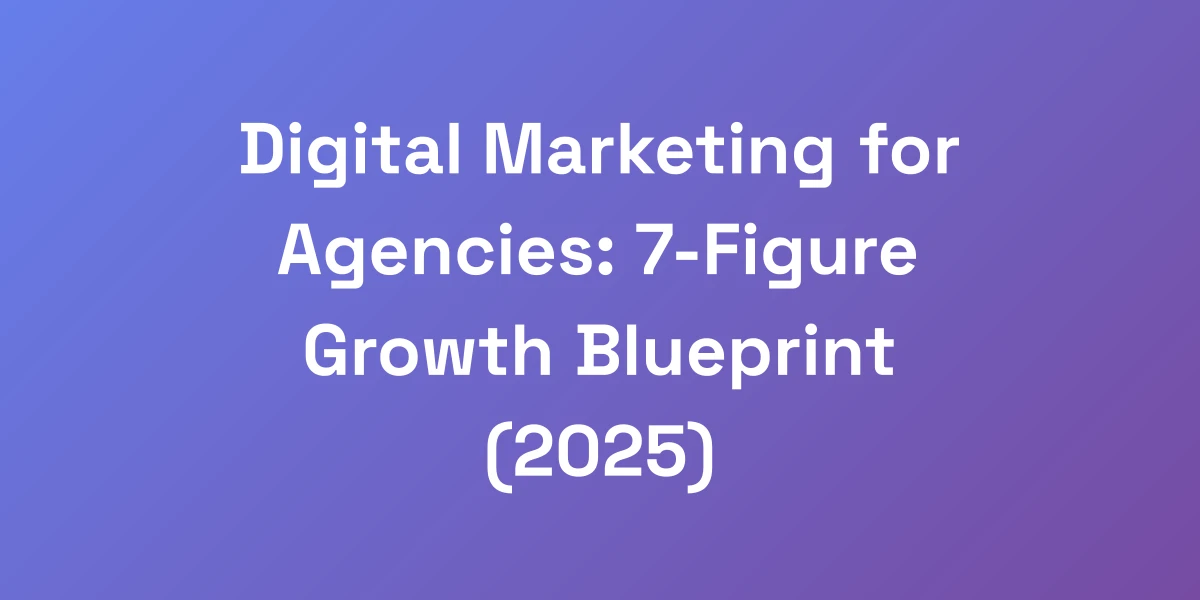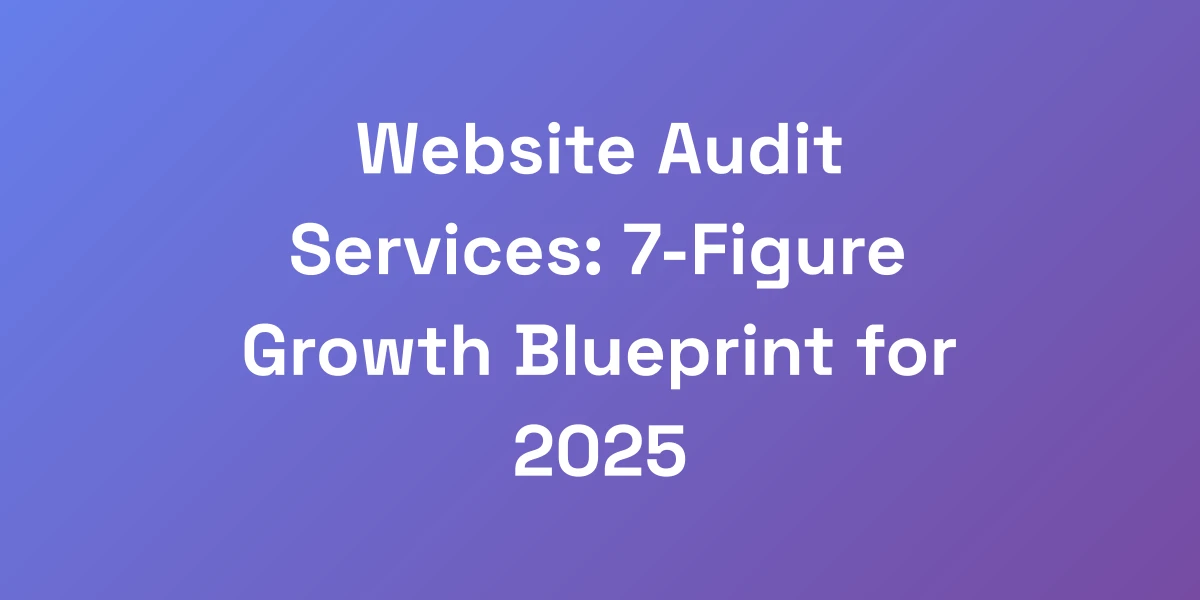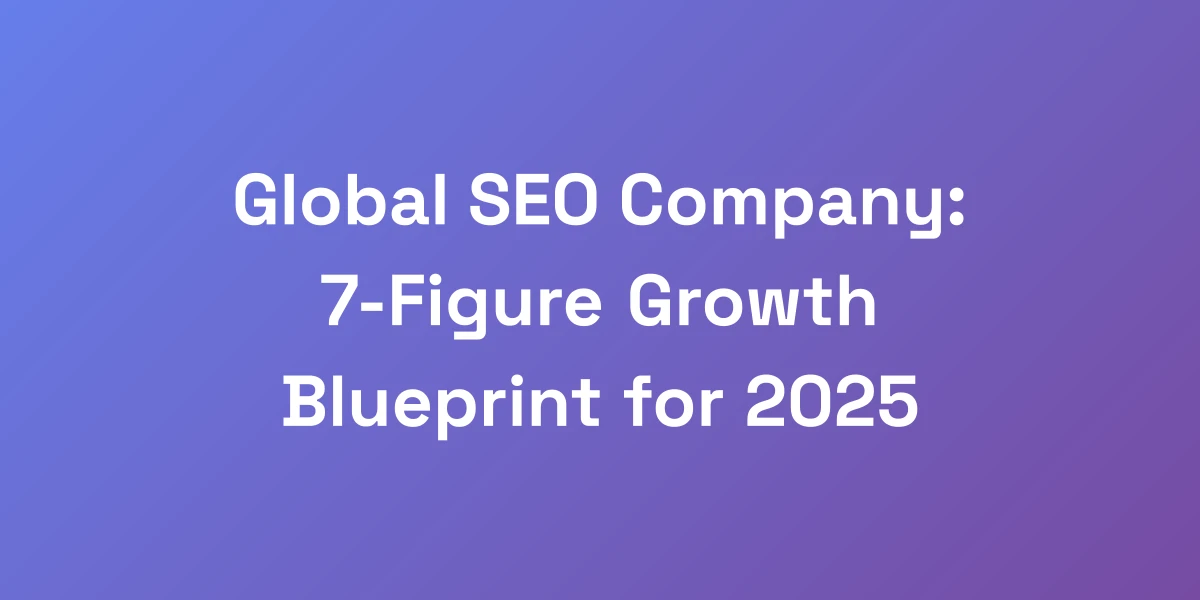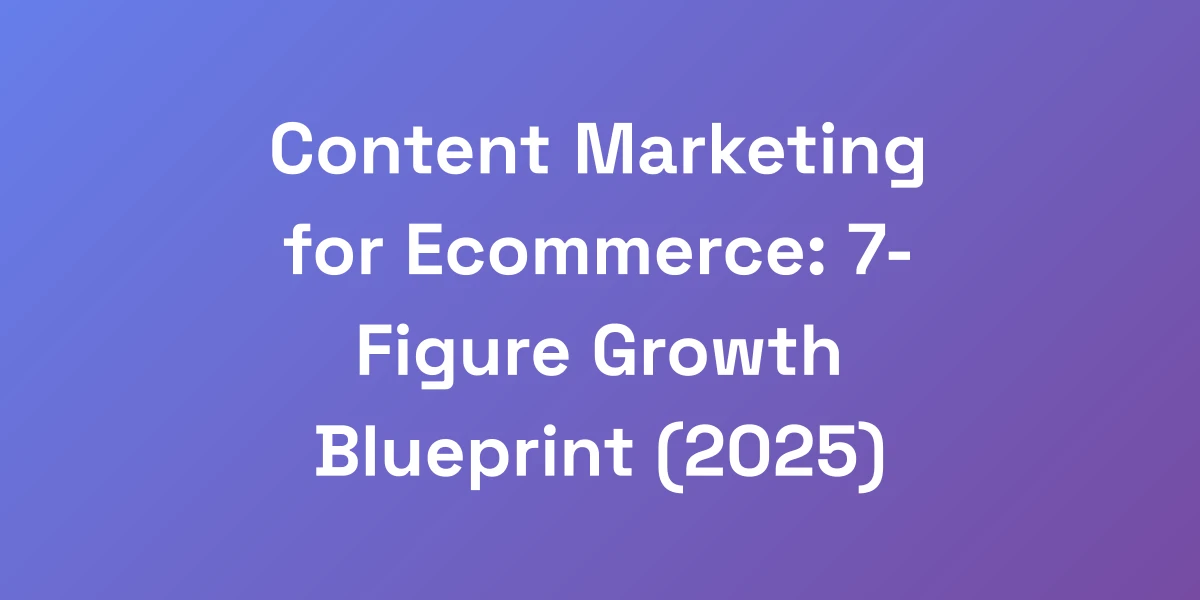
Content Marketing for Ecommerce: 7-Figure Growth Blueprint (2025)
Mar 13, 2025 | By [email protected]
Introduction
Let’s get straight to it.
In the sprawling world of ecommerce, content marketing isn’t just another checkbox on your to-do list—it’s the lifeblood of sustainable growth.
But here’s the kicker: while businesses churn out endless blog posts and social media updates, a staggering 95% of their efforts fall flat.
Why? Because most ecommerce content marketing is fundamentally broken.
It’s not enough to create content. You need to create content that converts. This isn’t about more content; it’s about smarter content.
We’ve scaled businesses to 7-figures and beyond by following a simple, yet powerful formula: deliver massive value upfront, showcase clear expertise, and seamlessly guide the customer to make a purchase.
Ready to break free from the content marketing madness that’s draining your resources? Let’s dive into the blueprint that can transform your ecommerce game in 2025.
Why Most Ecommerce Content Marketing Fails (And What Actually Works)
Let’s face it—most ecommerce content marketing is a mess. Generic blog posts, lifeless social media updates, and uninspiring videos are jammed out daily.
But why aren’t these efforts translating into sales? It’s simple: they lack strategy.
The Fatal Flaws in Traditional Ecommerce Content
Traditional content marketing often misses the mark because it’s not aligned with the buyer’s journey.
Here are the top flaws we’ve identified:
- Generic Messaging: Content that doesn’t speak directly to your target audience’s pain points.
- Lack of Value: Content that doesn’t offer actionable insights or solve real problems.
- Poor SEO Practices: Ignoring keyword optimization and entity optimization, leading to low visibility.
- No Clear CTA: Content that leaves the reader hanging without guiding them towards the next step.
Are you guilty of any of these? If yes, it’s time to rethink your approach.
The Value-First Content Framework
We’re not here to play the numbers game. Quality trumps quantity every single time.
Our Value-First Content Framework ensures every piece of content you create delivers real value to your audience.
Here’s how:
- Identify Core Problems: Understand the challenges your customers face.
- Deliver Solutions: Create content that offers actionable solutions and expert insights.
- Build Trust: Consistently provide valuable content to establish your authority in the niche.
Imagine your content as a trusted advisor guiding your customers through their buying journey. That’s the power of value-centric content.
Why Most Businesses Get ROI Wrong
ROI isn’t about how much you spend; it’s about the results you get.
Most businesses track the wrong metrics, focusing on vanity stats like page views and social shares instead of what truly matters.
We prioritize metrics that directly impact your bottom line:
- Revenue per Content Piece: Evaluate how much each content asset contributes to your sales.
- Customer Acquisition Cost: Determine the cost of acquiring a customer through specific content channels.
Shifting your focus to these metrics can transform how you perceive and measure the success of your content marketing efforts.
The Psychology Behind High-Converting Content
Understanding human psychology is crucial in crafting content that drives conversions.
We tap into psychological triggers that influence buying decisions:
- Social Proof: Showcasing user-generated content and testimonials builds trust.
- Scarcity: Limited-time offers create a sense of urgency.
- Authority: Positioning your brand as an expert increases credibility.
By weaving these elements into your content, you can significantly boost your conversion rates.
Setting Up Your Content for Maximum Impact
Creating great content is just half the battle. Ensuring it reaches and resonates with your audience is where the real work begins.
Here’s our playbook for setting up your content for maximum impact:
- Content Distribution Plan: Identify the most effective channels for your audience.
- SEO Optimization: Use advanced SEO techniques to enhance visibility.
- Engaging Formats: Utilize a mix of videos, infographics, and interactive content to keep your audience engaged.
Implementing these strategies ensures your content not only reaches but also captivates your target audience.
The $100M Ecommerce Content Strategy Blueprint
Stop thinking like a content creator and start thinking like a business owner.
Your content strategy needs to be a profit-generating machine, not a vanity metrics game.
We’ve perfected a framework that transforms content into cash flow, generating over $100M in ecommerce sales for our clients.
The secret? Building what we call Value Bridges—strategic content pieces that naturally guide customers from problem awareness to purchase decision.
Mapping Your Customer’s Value Journey
Understanding your customer’s journey is the foundation of effective content marketing.
We map out each stage of the journey:
- Awareness: Content that introduces your brand and highlights the problems you solve.
- Consideration: In-depth content that educates and provides solutions.
- Decision: Content that convinces and facilitates the purchase decision.
By aligning your content with each stage, you ensure a seamless customer journey that drives conversions.
Creating Content That Pre-Frames Purchase
Don’t just inform—prepare your audience for the buying decision.
Pre-framing involves subtly positioning your products as the ideal solution before the customer even realizes they need it.
Here’s how we do it:
- Educational Content: Teach your audience about their problems and potential solutions.
- Case Studies: Showcase real-life examples of how your products have helped others.
- Testimonials: Let satisfied customers vouch for your products’ effectiveness.
This approach builds anticipation and readiness, making the actual purchase decision almost inevitable.
The 3×3 Content Matrix for Maximum ROI
Efficiency is key when scaling content marketing efforts.
Our 3×3 Content Matrix ensures maximum ROI by categorizing content into three primary types and distributing them across three platforms.
Here’s the breakdown:
- Blog Posts: In-depth articles that drive SEO and educate customers.
- Videos: Engaging visual content that boosts conversions.
- Social Media Posts: Short, impactful messages that increase brand visibility.
Placing each content type on the right platform amplifies its effectiveness, ensuring you’re getting the most out of every piece of content.
Automation and Scaling Strategies
Scaling your content marketing without burning out requires smart automation.
We leverage tools like StoryChief and ChatGPT to automate repetitive tasks, allowing our team to focus on strategy and creativity.
Here are our top strategies:
- Content Scheduling: Automate your publishing schedule to maintain consistency.
- Email Automation: Use personalized email sequences to nurture leads.
- Analytics Automation: Track performance metrics automatically to make data-driven decisions.
These strategies help us scale content operations efficiently, driving more revenue without increasing overheads.
Content Distribution Channels That Actually Work
Not all distribution channels are created equal. Focusing on the right ones can make or break your strategy.
We prioritize channels that deliver the highest ROI:
- Email Marketing: With a conversion rate of 10.3%, email remains a powerhouse for driving sales.
- Social Media: Platforms like Instagram and TikTok offer unparalleled engagement opportunities.
- Organic Search: High-quality, SEO-optimized content ensures a steady stream of targeted traffic.
By concentrating on these channels, we maximize our content’s reach and effectiveness.
High-Converting Content Types for Ecommerce
Here’s the truth no one’s telling you about ecommerce content: it’s not about the format, it’s about the transformation you’re promising.
We focus on content that simultaneously educates and sells, creating buying momentum.
After testing dozens of formats across hundreds of businesses, these are the ones that consistently deliver the highest ROI:
Product Education Content That Sells
Educate your customers about your products in a way that highlights their benefits and solves their problems.
Our approach includes:
- Detailed Guides: Comprehensive explanations of product features and benefits.
- Tutorial Videos: Step-by-step videos showing how to use your products effectively.
- Webinars: Live sessions where you can interact with your audience and address their questions.
This type of content not only informs but also builds trust, making customers more likely to buy.
User-Generated Content Strategy
There’s nothing more powerful than content created by your customers.
User-generated content (UGC) builds trust and authenticity. Consider these tactics:
- Customer Reviews: Showcase real feedback from satisfied customers.
- Social Media Hashtags: Encourage customers to share their experiences using a branded hashtag.
- Photo Contests: Run contests where customers submit photos of them using your products.
By leveraging UGC, you create social proof that can significantly boost conversions.
Behind-the-Scenes Content
People love to see what goes on behind the curtain.
Creating behind-the-scenes content humanizes your brand and builds a deeper connection with your audience.
Try these ideas:
- Company Culture: Showcase your team and the values that drive your business.
- Production Process: Give a glimpse into how your products are made.
- Day-in-the-Life: Feature a day in the life of one of your employees or customers.
These insights make your brand more relatable and trustworthy.
Expert Roundups and Collaborations
Collaborating with industry experts can amplify your content’s reach and credibility.
Here’s how to do it right:
- Guest Posts: Invite experts to contribute to your blog or participate in your webinars.
- Interviews: Conduct interviews with thought leaders and share their insights with your audience.
- Collaborative Projects: Partner with other brands or influencers to create joint content.
These collaborations position your brand as an authority and attract a wider audience.
Problem-Solution Content Framework
Addressing your audience’s problems directly is a surefire way to capture their attention.
Our framework involves:
- Identifying Pain Points: Understand the specific challenges your customers face.
- Providing Solutions: Offer actionable solutions that your products can deliver.
- Demonstrating Results: Use case studies and testimonials to show the effectiveness of your solutions.
This approach ensures your content is not only relevant but also highly actionable, driving conversions.
Measuring and Scaling Your Content ROI
If you can’t measure it, you can’t improve it. But here’s the catch—most businesses track the wrong metrics.
Forget about vanity metrics like page views and social shares. What really matters is revenue per content piece and customer acquisition cost.
We’ll walk you through the exact steps to track these metrics and scale your content operation from 5-figures to 7-figures per month.
Key Performance Indicators That Matter
Focusing on the right KPIs is crucial for assessing the effectiveness of your content strategy.
Here are the KPIs we prioritize:
- Revenue Generated: Track how much each content piece contributes to overall sales.
- Conversion Rates: Measure the percentage of visitors who make a purchase after consuming your content.
- Customer Acquisition Cost: Calculate the cost of acquiring a new customer through specific content channels.
- Engagement Metrics: Monitor likes, shares, comments, and time spent on content to gauge audience interaction.
By focusing on these indicators, you can make informed decisions that drive profitability.
Content ROI Calculation Framework
Calculating ROI for your content marketing efforts doesn’t have to be complicated.
Here’s our simple framework:
- Total Revenue from Content: Sum up all the sales directly attributed to your content pieces.
- Total Content Costs: Include all costs related to creating, distributing, and promoting the content.
- ROI Formula: (Total Revenue – Total Content Costs) / Total Content Costs x 100 = ROI%
This straightforward approach allows you to measure the financial impact of your content and adjust your strategy accordingly.
Scaling Systems and Processes
Scaling your content marketing without losing quality requires robust systems and processes.
Here’s what we implemented:
- Content Calendar: Plan and schedule your content in advance to ensure consistency.
- Workflow Automation: Use tools to automate repetitive tasks, freeing up your team to focus on strategy and creativity.
- Performance Reviews: Regularly assess content performance and iterate based on data-driven insights.
These systems ensure your content marketing efforts are scalable and sustainable, driving continuous growth.
Content Team Structure and Hiring
Building a high-performing content team is essential for sustained success.
Here’s our recommended structure:
- Content Strategist: Oversees the overall content strategy and ensures alignment with business goals.
- Content Creators: Writers, designers, and videographers who produce high-quality content.
- SEO Specialist: Focuses on optimizing content for search engines and improving organic visibility.
- Content Manager: Coordinates the content production process and manages the editorial calendar.
When hiring, prioritize versatility and the ability to adapt to different content formats and strategies.
Automation Tools and Technology Stack
Leveraging the right tools can drastically improve your content marketing efficiency.
We rely on a few key tools to streamline our operations:
- StoryChief: Automates content strategy creation, keyword research, topic ideation, content generation, and SEO optimization.
- ChatGPT: Generates human-like text responses, automates content creation, and personalizes messaging.
- ContentShake AI: Provides AI-driven content automation services, including trend analysis and SEO-friendly content creation.
These tools help us maintain high-quality content output while reducing manual effort and costs.
Advanced Content Optimization Techniques
Most ecommerce businesses leave money on the table by not optimizing their existing content.
Here’s the truth: optimization is often more valuable than creation.
We’ve seen individually optimized pieces outperform entire content calendars. Let me share our exact process for turning underperforming content into revenue-generating assets using data-driven optimization techniques.
Content Conversion Rate Optimization
The ultimate goal is to convert readers into buyers. Here’s how to optimize for higher conversion rates:
- Compelling CTAs: Use clear and persuasive calls-to-action that guide users towards the next step.
- Optimized Landing Pages: Ensure that landing pages are designed for conversions, with relevant content and minimal distractions.
- User Experience: Improve site navigation, loading speed, and mobile responsiveness to enhance the overall user experience.
Small tweaks can lead to significant uplifts in conversion rates.
SEO Enhancement Strategies
SEO isn’t just about keywords; it’s about understanding user intent and delivering relevant content.
Our advanced SEO strategies include:
- Keyword Optimization: Conduct thorough keyword research and integrate relevant terms naturally into your content.
- Entity Optimization: Use structured data and semantic keywords to enhance your content’s relevance and authority.
- On-Page SEO: Optimize meta tags, headings, and internal linking to improve search engine visibility.
These strategies ensure your content ranks higher and attracts more targeted traffic.
Mobile Optimization Techniques
With 72% of global ecommerce sales conducted via mobile, optimizing your content for mobile is non-negotiable.
Here’s how to get it right:
- Responsive Design: Ensure your website adapts seamlessly to different screen sizes and devices.
- Fast Load Times: Compress images and use efficient coding practices to minimize loading times.
- Mobile-Friendly Content: Use short paragraphs, bullet points, and clear headings to make content easy to read on mobile devices.
Optimizing for mobile can significantly enhance user experience and boost conversions.
A/B Testing Framework
Testing is essential for determining what works and what doesn’t.
Our A/B testing framework involves:
- Hypothesis Creation: Identify what you want to test and predict the outcome.
- Variable Selection: Choose specific elements to test, such as headlines, CTAs, or images.
- Data Analysis: Collect and analyze data to determine which variant performs better.
- Implementation: Apply the winning variant and iterate on further tests.
Continuous testing and optimization help you fine-tune your content for maximum performance.
Content Update Strategy
A lot of businesses overlook the potential of their existing content. Updating old content can yield substantial returns.
Here’s our strategy:
- Regular Audits: Conduct periodic reviews of your content to identify outdated information or opportunities for improvement.
- Content Refresh: Update statistics, add new insights, and optimize for current SEO best practices.
- Repurposing Content: Turn high-performing content into different formats, like videos or infographics, to reach a broader audience.
By keeping your content fresh and relevant, you ensure it continues to attract and convert customers.
Conclusion
There you have it—a comprehensive blueprint to elevate your ecommerce content marketing to 7-figure heights by 2025.
We’ve dissected the common pitfalls, introduced strategies that work, and shared actionable tips to optimize every aspect of your content strategy.
Remember, it’s not about creating more content; it’s about creating content that converts.
Ready to take your ecommerce business to the next level? Start implementing these strategies today and watch your revenue soar.
What’s your biggest content marketing challenge right now? Drop your thoughts below and let’s conquer it together!


